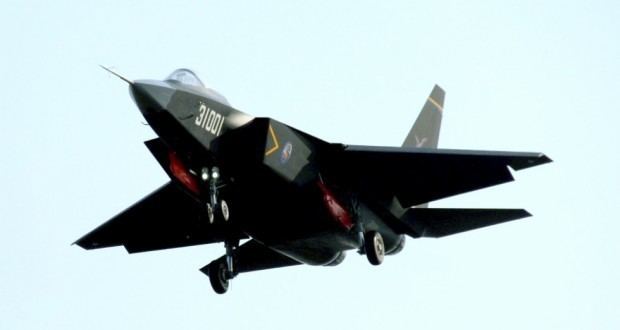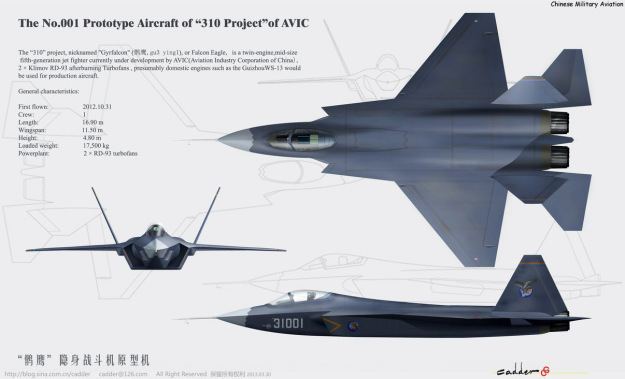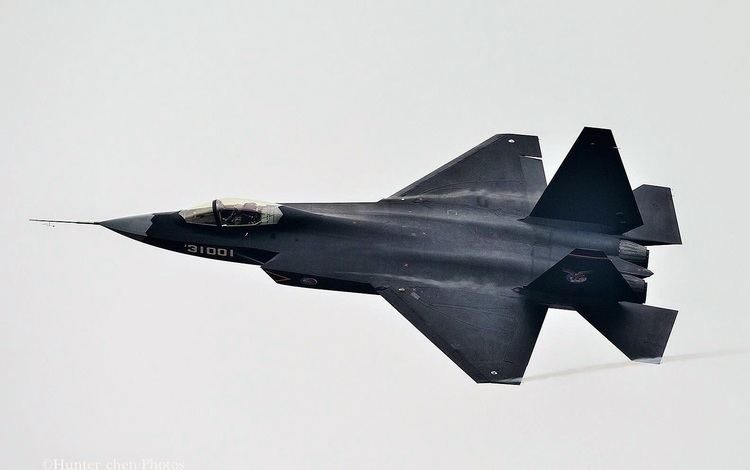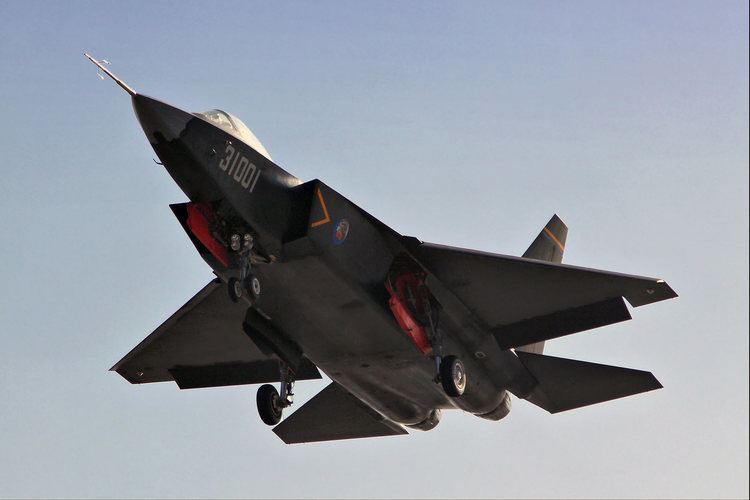Top speed 2,200 km/h Wingspan 12 m Number built 3 prototypes | Length 17 m First flight October 31, 2012 Role Stealth multirole fighter | |
 | ||
Manufacturer Shenyang Aircraft Corporation | ||
Shenyang j 31 rc plane
The Shenyang J-31 (or "FC-31 fifth Generation Multi-Purpose Medium Fighter") also known as the "Gyrfalcon" (鹘鹰), or "Falcon Hawk" by some military enthusiasts, is a twin-engine, mid-size fifth-generation jet fighter currently under development by Shenyang Aircraft Corporation. The fighter has also been referred to as the "F-60" or "J-21 Snowy Owl" (雪鸮) in some media reports. Its official name is Shenyang FC-31; J-xx nomenclatures in the Chinese military are reserved to programs launched and financed by the army, while this plane was developed by a private company.
Contents
- Shenyang j 31 rc plane
- Development
- Flight testing
- Public unveiling
- Future
- Design
- Airframe
- Engines
- Payload
- Stealth
- Foreign reactions
- Specifications estimated
- References

Development

A photo of a model labeled F-60 was posted on the Internet in September 2011. In June 2012, photos and camera video clips started to emerge on internet about a heavily overwrapped possible F-60 prototype being road-transferred on a highway, earning the nickname "the zongzi plane" (粽子机) among Chinese netizens, though some suspect it of merely being a L-15 trainer aircraft. Pictures of a possibly fully assembled aircraft parking on an airfield emerged on September 15–16, 2012. The F-60 is reported to be the export version, where the J-31 would be the domestic Chinese version of the same fighter. Chinese aviation expert Xu Yongling has called the J-31 an export-oriented low-end latest generation warplane.
Flight testing

The prototype conducted a high-speed taxiing test and briefly became airborne. On 31 October 2012, prototype No. 31001 conducted the model's maiden flight. It was accompanied by two J-11 fighters in a ten-minute test flight with its landing gear lowered.

With the maiden test flight of the prototype No.31001 on October 31, 2012, China became the second nation after the 1991 Advanced Tactical Fighter fly off, to have two stealth fighter designs in field-testing at the same time. The aircraft has continued a limited test program, with footage emerging of further flights which took place in February 2013.
Public unveiling

A 1/4 scale model of the J-31 was shown at the China International Aviation & Aerospace Exhibition 2012, hinting at a desire to offer the aircraft for export, as an alternative for those countries that cannot purchase the F-35.
The J-31 airframe was publicly unveiled on November 12, 2014 at Zhuhai Airshow. In TV broadcast of the unveiling, AVIC chairman Lin Zuoming claimed that funding for the aircraft came entirely from the company, with no input from military.
As typical in flight displays of fighter jets, afterburners were engaged throughout the maneuvers. Nevertheless, Western media claimed it to be evidence of aerodynamic inefficiencies, concluding that the aircraft "bleeds a lot of energy and the pilot had a hard time keeping the nose up." Flights were done when the jet was "clean," so results would be worse when fitted with a combat loadout. However, a large-scale model of the FC-31 on display did show some detail changes of configuration compared to the flying prototype.
At the 2015 Dubai Airshow, AVIC released more details regarding the aircraft's capabilities. The company revealed it is still looking for a partner in the aircraft project, and is actively marketing the aircraft to People's Liberation Army Air Force. AVIC's plan is to have a production model first flight by 2019.
Future
Due to mixed reports from China, it is unknown as to whether the J-31 will be inducted as a naval fighter, or only intended for foreign customers. In one interview with China's state media, the J-31's chief designer Sun Cong expressed his hope that the aircraft would follow his J-15 onto China's aircraft carriers. However, officials from AVIC only said that the aircraft was intended for export as a competitor to the F-35. According to various verifiable sources Pakistan is interested in procuring this fighter from China and advanced stages of talks are underway.
In 2015, Jiangsu A-Star Aviation Industries Company marketed its EOTS-86 infra-red search and track as a possible addition to the J-31.
An improved prototype, with modifications to the vertical stabilizers, wings, and airframe, an electro-optical targeting system, a larger payload, improvements in stealth, and upgraded electronics, made its maiden flight in December 2016.
Design
J-31 incorporates certain stealth characters such as forward swept intake ramps with diverterless supersonic inlet (DSI) bumps and a two-piece canopy.
Airframe
The J-31 is smaller than the Chengdu J-20. The use of twin-wheel nose landing gear led to speculations that the J-31 may intended to be a carrier based fighter. Bill Sweetman has cited several improvements to the F-35C design files the Chinese may have acquired in the J-31. Like the F-35, the J-31 has two internal weapons bays that can each carry two medium range missiles, along with two heavy hardpoints and one light hardpoint on each wing, but while it seems to have added an additional light hardpoint to each wing over the capacity of the F-35, it seems to lack the capacity of the F-35 to mount a centerline gunnery or jamming pod.
Official from AVIC claimed that additive manufacturing was extensively used on the aircraft, resulting in 50% reduction in components compared to similar aircraft. However, the resulting airframe cannot be disassembled, and the static test frame had to be transported in whole as consequence.
Engines
According to Vladimir Barkovsky of Russian Aircraft Corporation MiG (formerly known as the Mikoyan-Gurevich Design Bureau), the engines on the prototype aircraft are RD-93s. However, China already has an engine similar to the RD-93, the Guizhou WS-13 currently installed on the JF-17 which has the same thrust and size of the Russian RD-93. China is working on an improved variant named WS-13E with 100KN of thrust for use on the J-31. Lin Zuoming, chairman of China's AVIC, has said that he hopes to put domestic engines on the fighter. As the Chinese build up confidence in newer, more reliable and powerful domestic engines, they may be able to power the J-31 sooner than the larger J-20 and in greater numbers.
Payload
The J-31 can carry 8000 kg (17637 lb) of payload, with four munitions totaling 2000 kg (4409 lb) internally, and 6000 kg (13228 lb) carried on six external hardpoints; primary armaments include the PL-10 short-range missile and SD-10A medium-range air-to-air missile. It has a combat radius of 648 nmi (746 mi; 1,200 km) and a maximum take-off weight of 25,000 kg (55,000 lb).
Stealth
The J-31 is speculated to use stealth coatings instead of "baked in" fiber-mat stealth. AVIC claimed the aircraft to be stealthy against L-band and Ku-band radars, and would be low-observable against a number of multi-spectrum sensors.
Foreign reactions
The appearance of the J-31 raised concern about a potential arms race in Asia, as some of China's neighbors pursuing the development of their own fifth generation aircraft I.e. India with their HAL AMCA and HAL FGFA, Japan with Mitsubishi X-2 and South Korea with KAI KF-X or consider purchasing the F-35 and PAK FA.
U.S. military and industry officials believe that once the J-31 enters service, it will automatically be a match for existing fourth-generation fighters like the F-15 Eagle, F-16 Fighting Falcon, and F/A-18 Super Hornet. They suggest that the capability of the J-31 against the newest fighters, such as the American F-22 and F-35, would depend on factors such as numbers of platforms, quality of pilots, and capabilities of radars and other sensors.
USAF Lieutenant General Charles Davis has said that while the Chinese fifth generation fighter may have used stolen information from the F-35 program, it was unlikely to measure up to the American aircraft.
Stephen Biddle of the Council for Foreign Relations has speculated that the aircraft design was intended for domestic use, but found to be under performing and hence relegated to the export market.
Vladimir Barkovsky of Russian Aircraft Corporation MiG (formerly known as the Mikoyan-Gurevich Design Bureau) has stated that, despite some design flaws, the J-31 "looks like a good machine." Although it contains features already in use on the U.S. fifth generation fighter designs, it is "not a copy but a well done indigenous design."
Specifications (estimated)
Because the aircraft is in development, these specifications — based on available imagery — are approximate and preliminary.
Data from Aviation Week unless otherwise attributed
General characteristics
Armament
Avionics
